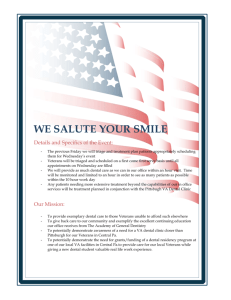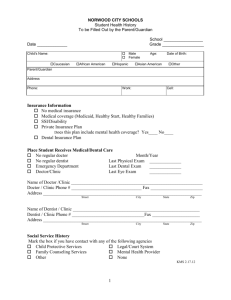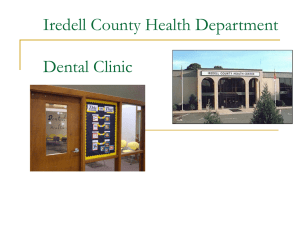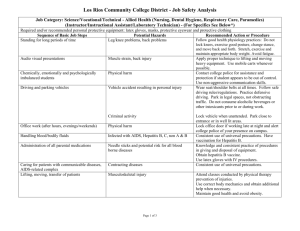Keeping our Patients Safe - Northern Arizona University
advertisement
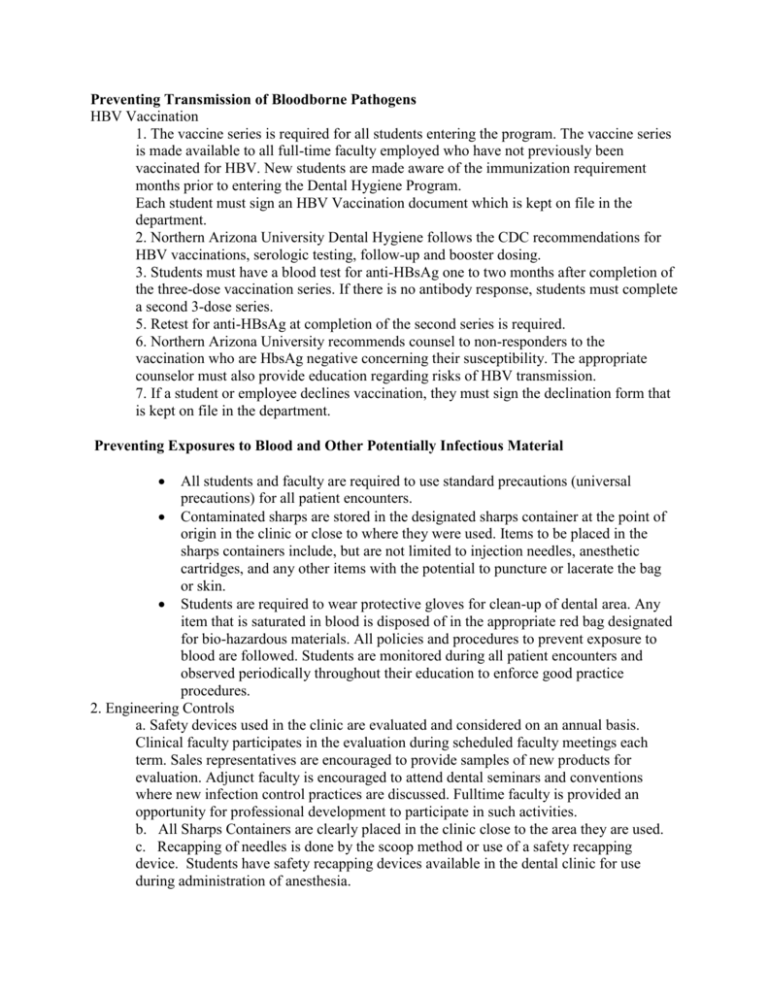
Preventing Transmission of Bloodborne Pathogens HBV Vaccination 1. The vaccine series is required for all students entering the program. The vaccine series is made available to all full-time faculty employed who have not previously been vaccinated for HBV. New students are made aware of the immunization requirement months prior to entering the Dental Hygiene Program. Each student must sign an HBV Vaccination document which is kept on file in the department. 2. Northern Arizona University Dental Hygiene follows the CDC recommendations for HBV vaccinations, serologic testing, follow-up and booster dosing. 3. Students must have a blood test for anti-HBsAg one to two months after completion of the three-dose vaccination series. If there is no antibody response, students must complete a second 3-dose series. 5. Retest for anti-HBsAg at completion of the second series is required. 6. Northern Arizona University recommends counsel to non-responders to the vaccination who are HbsAg negative concerning their susceptibility. The appropriate counselor must also provide education regarding risks of HBV transmission. 7. If a student or employee declines vaccination, they must sign the declination form that is kept on file in the department. Preventing Exposures to Blood and Other Potentially Infectious Material All students and faculty are required to use standard precautions (universal precautions) for all patient encounters. Contaminated sharps are stored in the designated sharps container at the point of origin in the clinic or close to where they were used. Items to be placed in the sharps containers include, but are not limited to injection needles, anesthetic cartridges, and any other items with the potential to puncture or lacerate the bag or skin. Students are required to wear protective gloves for clean-up of dental area. Any item that is saturated in blood is disposed of in the appropriate red bag designated for bio-hazardous materials. All policies and procedures to prevent exposure to blood are followed. Students are monitored during all patient encounters and observed periodically throughout their education to enforce good practice procedures. 2. Engineering Controls a. Safety devices used in the clinic are evaluated and considered on an annual basis. Clinical faculty participates in the evaluation during scheduled faculty meetings each term. Sales representatives are encouraged to provide samples of new products for evaluation. Adjunct faculty is encouraged to attend dental seminars and conventions where new infection control practices are discussed. Fulltime faculty is provided an opportunity for professional development to participate in such activities. b. All Sharps Containers are clearly placed in the clinic close to the area they are used. c. Recapping of needles is done by the scoop method or use of a safety recapping device. Students have safety recapping devices available in the dental clinic for use during administration of anesthesia. Hand Hygiene A. General Considerations Students and faculty use the “Initial Scrub” technique at the start of the day allowing 2 to 3 minutes for this first hand washing. Following the initial scrub the students and faculty use the “short standard scrub “technique of three short latherings and three rinses in 30 seconds. (Reference: Wilkins, Clinical Practice of the Dental Hygienist, 8th Edition, Pg. 49-50.) NAU Dental Hygiene Clinic has approved antimicrobial soap available at every hand washing station that is used for hand washing. No substitute is allowed. 2. Hand washing is performed at the beginning of the day, after touching contaminated objects bare-handed, before and after de-gloving, and whenever hands are visibly soiled. B. Special Considerations for Hand Hygiene and Glove Usage 1. It is recommended that all students and faculty use hand lotion at the end of the day in order to prevent dryness and chapping of the hands. 2. Fingernails are kept clean, trimmed, smooth, and well groomed. Fingernails cannot extend beyond the pad of the finger. An orangewood stick (cuticle stick) is recommended for cleaning under the nail when washing hands at the beginning of the day. 3. Artificial nails are not allowed in clinic. 4. Jewelry cannot be worn on the fingernails and rings cannot be worn for patient treatment. NAU Dental Hygiene policy states that only a plain wedding band can be worn under examination gloves. Personal Protective Equipment (PPE) Personal protective barriers for the dental hygiene include utility gloves, examination gloves, masks, protective eyewear or face shield, and disposable gowns. A. Masks, Protective Eyewear, Face Shields Students must wear a surgical mask and eye protection to protect mucous membranes of the eyes, nose and mouth during procedures likely to generate splashing or spattering of blood or other body fluids. Masks are changed between patients or during patient treatment if the mask becomes contaminated with moisture or visibly soiled. Face shields or eye protection should be cleaned with soap and water and disinfected between patients or if visibly soiled during treatment. B. Protective Clothing Students wear a disposable gown over regulation uniform or scrub. Change disposable gown if visibly soiled or contaminated by blood or other potentially infectious materials. Gowns are worn during patient treatment. Upon leaving the clinic, the gowns are removed. Gowns are hung in operatory until returning to the treatment area. C. Gloves When dental hygiene students leave the patient to request an instructor’s assistance, gloves are removed before touching the sign-up sheet. Hands are washed and fresh gloves used when returning to treatment area. 1. Students are required to wear examination gloves when the potential exists for contacting blood, saliva, or other potentially infectious material. 2. Students are required to wear a new pair of examination gloves for each patient, remove them promptly after use, and wash hands immediately to avoid transfer of microorganisms to other patients or environmental surfaces. 3. Students are required to remove gloves that are torn, cut or punctured immediately and wash hands before re-gloving. 4. Patient examination gloves are never washed for reuse.. 5. Appropriate gloves in the correct size are readily accessible to all students and faculty. 6. Students and faculty use appropriate gloves (e.g., puncture-and-chemicalresistant utility gloves) when cleaning instruments and performing housekeeping tasks involving contact with blood or “Other Potentially Infectious Materials” (OPIM). 7. Faculty consult with glove manufacturers if questions arise regarding the chemical compatibility of glove material and dental materials used. Sterilization and Disinfection of Patient-Care Items A. General Recommendations 1. The clinic only uses FDA-approved medical devices for sterilization and follows the manufacturer’s instructions for correct use. 2. Cleans and heat sterilizes critical dental instruments before each use. 3. Cleans and heat sterilizes semi-critical items before each use. 4. Allow packages to dry in the sterilizer before they are handled to avoid contamination. 5. Use of heat-stable semi-critical alternatives is encouraged. 6. Single-use disposable supplies and instruments are used whenever possible. 7. Ensure that non-critical patient-care items are barrier-protected or cleaned or, if visible soiled, cleaned and disinfected after each use with an PA-registered hospital disinfectant with an HIV,HBV effectiveness claim (low-level disinfectant) or tuberculocidal claim (intermediate-level) B. Instrument Processing/Recirculation Area The instrument processing/recirculation area is located in the dental clinic and is divided into specific areas to represent the steps in instrument processing. Receiving Soiled instruments and cassettes are placed in the instrument washer designated as “contaminated” and assists in minimizing the risk associated with hand scrubbing instruments Packaging Instruments/items are wrapped/ bagged and labeled using appropriate materials for heat sterilization. Sterilization Instruments are sterilized in either the large or small heat sterilizer. Marked containers are available for packages waiting to be sterilized. Storage Dry packaged instruments are stored in individual student storage spaces in the instrument cabinet. Miscellaneous instruments/items are stored in labeled containers in the storage area, separate from the contaminated and preparation sections. This is a clean, dry environment designed to maintain the integrity of the package. Quality Assurance in the instrument recirculation process is monitored and maintained by students assigned to Clinic Assistant rotation and supervised by Clinic Manager Process/biologic monitoring is used in the packaging section. All students/faculty are trained in the instrument recirculation process. All students/faculty are trained in recordkeeping in the instrument recirculation process. All students/faculty are trained in the processing area equipment cleaning and maintenance. The large regulated (bio hazardous) waste receptacle designated with the international bio-hazardous symbol is located in the processing area. Ultrasonic cleaning solutions, intermediate level disinfectants and high level disinfectant/ sterilants, instrument packaging materials, and process/biologic monitoring materials are readily available in the processing area. Proper personal protective equipment is worn by individuals working in the processing area. Environmental Infection Control General Procedures Faculty and students follow the manufacturers’ instructions for correct use of cleaning and EPA registered hospital disinfecting products. Use PPE, as appropriate, when cleaning and disinfecting environmental surfaces. Such equipment might include gloves (puncture and chemical resistant utility), protective clothing (disposable gown), and protective eyewear/ nitrile gloves and mask. Clinical Contact Surfaces Surface barriers are used to protect clinical contact surfaces, particularly those that are difficult to clean (e.g., switches on dental chairs) and surface barriers are changed between patients. Clinical contact surfaces that are not barrier protected are cleaned and by using an EPAregistered hospital disinfectant with low-(i.e., HIV and HBV label claims) to intermediate level (i.e., tuberculocidal claim) after each patient. Intermediate level disinfectants are used if visibly contaminated with blood. Cavicide is the product presently being used in the NAU Dental Hygiene Clinic. Housekeeping Surfaces Housekeeping surfaces (e.g., sinks and countertops) are cleaned with an EPA-registered hospital disinfectant/detergent on a daily basis. The NAU Dental Hygiene Clinic is currently using Cavicide for this purpose. This duty is carried out by the student assigned to the rotation of Clinic Assistant at the end of each day. Regulated Medical Waste Blood saturated items are disposed of in the trash container marked “Bio-hazardous” that contains a red bag. Examples of these items are operator’s gown, gloves, gauze, cotton swabs, cotton rolls, patient napkins, and patient wipes or facial tissues, and barriers if visibly saturated with blood. All other items are disposed of in the container with a bag liner of a color other than red. Examples of these items are operator gowns, paper towels, plastic barriers and face masks unless visibly soiled with blood, paper cups, paper boxes, autoclave wrap and autoclave bags. Sharp items (e.g., needles, anesthetic carpules and wooden cotton tipped applicators) are placed in the designated red sharps container, which is located at the point of origin. The student assigned to Clinic Assistant rotation is responsible for tying up the red and non-red liner bags once they have reached capacity, while wearing heavy duty utility gloves. The non-red bags are tied and placed in the designated container. After emptying, new bags are placed in the appropriated containers. Dental Unit Water Lines, Biofilm and Water Quality General Procedures Water that meets EPA regulatory standard for drinking water for routine dental treatment is used in self-contained water delivery systems at each dental chair. Clinic dental units have self-contained water systems that require special care for water line care and maintenance per the manufacturer’s instructions. Students only fill water bottles with distilled water. Ultrasonic scaling devices require a two minute flush before placement of the insert. Water and air is discharged for a minimum of 20-30 seconds after each patient, from any device that enters the patient’s mouth (e.g., hand pieces, ultrasonic scalers and air/water syringes). Boil-Water Advisories - in these situations, the clinic will be closed.

